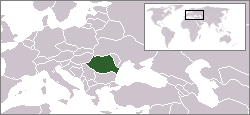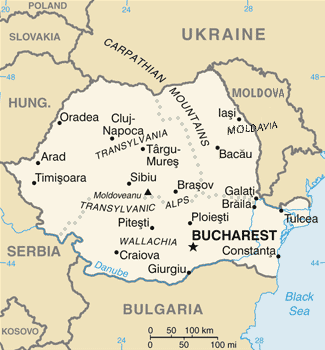Romania
Romania (formerly spelled Rumania or Roumania) is a country in southeastern Europe. Romania is bordered by Ukraine and Moldova in the northeast, Hungary and Serbia in the west and Bulgaria to the south. Romania also has a small sea coast on the Black Sea.
| |||||
| National motto: none | |||||

| |||||
| Official language | Romanian | ||||
| Capital | Bucharest | ||||
| President | Ion Iliescu (outgoing) Traian Băsescu (elected) | ||||
| Prime Minister | Adrian Năstase | ||||
| Area - Total - % water | Ranked 78th 238,391 km² 3.0% | ||||
| Population - Total (2002) - Density | Ranked 49th 21,698,181 91.3/km² | ||||
| Independence | 9 May 1877 (from the Ottoman Empire) | ||||
| Currency | Leu | ||||
| Time zone | UTC +2/+3 | ||||
| National anthem | Deşteaptă-te, Române! | ||||
| Internet TLD | .ro | ||||
| Calling Code | 40 | ||||
Name
The name Romania comes from Rome or the (Eastern) Roman Empire and asserts the country's origins as a Roman Empire province. In Late Antiquity the Roman Empire was often called Romania in Latin. Some historians have argued that the medieval Byzantine Empire should more properly be called Romania, but this has not caught on.
"Romania" is also used for the set of European lands where Romance languages appeared.
History
Main article: History of Romania
The tribal confederation of the Getae were encountered by Darius in his campaign in the Balkans in 531 BC. The Dacians were defeated by the Roman Empire under Emperor Trajan in two campaigns stretching from 101 to 107, and the core of their kingdom became the Roman province Dacia. The Gothic and Carpic campaigns in the Balkans during 231 - 275 forced the Roman Empire to reorganise a new roman province of Dacia south of Danube, the ancient Dacia becoming the kingdom of the Goths until the end of fourth century when it was included in the Hunnic Empire. The Gepids and the Avars ruled Transylvania until eighth century, thence the Bulgars included Romania in their Empire until 1000. The Pechenegs, the Cumans and Uzes were also mentioned by historic chronicles on the teritory of Romania until the founding of the valachian principalities of Wallachia by Basarab, and Moldavia by Dragos during the 14th century.
In the Middle Ages, Romanians lived in three distinct principalities: Wallachia, Moldavia (also Moldova) and Transylvania.
Wallachia and Moldavia came under the suzeranity of the Ottoman Empire in 15th and 16th century respectively, with internal autonomy, and brief periods of independence, Moldova losing its eastern side Bessarabia to the Russian Empire in 1812, its northern part Bukovina to the Austrian Empire in 1775 and its south-eastern part Bugeac to the Ottoman Empire
Transylvania came under Hungary's control by 12th century (since 1300 Hungary and Transylvania became possesions of House of Anjou, of Habsburg, and of Holy Roman Empire), becoming a Principality under the suzerainty of the Ottoman Empire in 1526, following the Battle of Mohacs. At the end of the 18th century, Austrian Empire (since 1867 Austria-Hungary) included Transylvania inside its borders.
The modern Romania was born when the principalities of Moldavia and Wallachia merged in 1859, and independency was ratified by the Great Powers in 1877. Following the WW I and the disintegration of the Russian Empire and Austro-Hungary, and the rise of Bolshevism in Hungary and Russia, Transylvania and Bessarabia opted for a Union with the Romanian Kingdom in 1918.
Bessarabia, N. Bukovina and Bugeac were incorporated by the Soviet Union in 1940, mostly comprising the present-day Republic of Moldova with Bugeac and N. Bukovina assigned to Ukraine. After the Second World War, Romania became a communist state under military and economic control of USSR until 1958.
The decades-long reign of president Nicolae Ceauşescu was ended with an uprising in late 1989, part of which, now reformed as social democrats continued to be present in the democratically elected government until 1996 when a center-right coalition government took power for one term. In 2000, social democrats returned to power and elections will be held on November 28th, 2004
See also: Kings of Romania
Politics
Main article: Politics of Romania
Romania is a democratic republic. The legislative branch of the Romanian government consists of two chambers, the Senat (Senate), which has 137 members (as of 2004), and the Camera Deputaţilor (Chamber of Deputies), which has 332 members (as of 2004). The members of both chambers are chosen in elections held every four years.
The president, the head of the executive branch, is also elected by popular vote, every five years (until 2004 - four years). The president appoints a prime minister, who heads the government, the members of which are in turn appointed by the prime minister. The government is subject to a parliamentary vote of approval.
Counties
Main article: Counties of Romania
Romania is divided into 41 judeţe, or counties, and the municipality of Bucharest (Bucureşti) - the capital.
The counties are (in alphabetical order):
Transylvania is green, Wallachia blue, the Moldavian region red, and Dobrogea yellow
Geography

Main article: Geography of Romania
A large part of Romania's borders with Yugoslavia and Bulgaria is formed by the Danube. The Danube is joined by the Prut River, which forms the border with Moldova.
The Carpathian Mountains dominate the western part of Romania, with peaks up to 2,500 m, the highest, Moldoveanu, reaching 2,544 m.
Major cities are the capital Bucharest, Braşov, Timişoara, Cluj-Napoca, Constanţa, Craiova, and Iaşi (Jassy).
See also:
Economy
Main article: Economy of Romania
After the collapse of the Soviet Bloc in 1989-91, Romania was left with an obsolete industrial base and a pattern of industrial capacity wholly unsuited to its needs.
In February 1997, Romania embarked on a comprehensive macroeconomic stabilisation and structural reform programme, but reform subsequently has been a frustrating stop-and-go process. Restructuring programs include liquidating large energy-intensive industries and major agricultural and financial sector reforms.
Romania's lagging and unstable economy has been transformed into one with macroeconomic stability, high growth and low unemployment.
Romania reached an agreement with the IMF in August for a USD $547 million loan, but release of the second tranche was postponed in October because of unresolved private sector lending requirements and differences over budgetary spending.
Bucharest avoided defaulting on mid-year lump-sum debt payments, but had to significantly draw down reserves to do so; reserves rebounded to an estimated $1.5 billion by year end 1999.
The government's priorities include: obtaining renewed IMF lending, tightening fiscal policy, accelerating privatisation, and restructuring unprofitable firms.
2002 and 2003 were successful economic years, and currently GDP growth is forecast at 4.5% per annum. The economy grew by 6.6% in the first half of 2004, and 7.0% (year-on-year) in the second quarter of 2004, marking the highest growth rate in the region. The average gross wage per month in Romania is 8,392,766 lei as of October 2004, an increase of 2.1% over the previous month. This equates to US$283.54, 213.60 euro and 360.21 AUD. The average net salary per month in January 2004 was 6,071,211 lei.
GDP growth should be around 8% in 2004 and around 6-7% in 2005.
Unemployment in Romania is at 6.2% (2004), which is very low compared to other European countries.
Romania was invited by the European Union in December 1999 to begin accession negotiations. It is expected to join the EU in 2007 along with Bulgaria.
Despite clear improvements, Romania still faces several key problems: rampant corruption on almost all levels of society, lack of transparency regarding public spendings, lack of economic competitivity - especially in the agricultural sector, some underemployment in rural areas and low pace of reform in the public (state owned) sector of economy.
Press freedom is generally granted, but some economic and administrative pressures determine media to reflect especially the positive or neutral aspects in the society, rather than the negative ones or critics addressed to the Government.
Romania was granted in October 2004 the much desired 'functional market economy' status by EU officials, with some reserves - especially related to aspects mentioned in the paragraph above.
Demographics
Main article: Demographics of Romania
Ethnic groups (2002 est.):
- Romanian 89.5%
- Hungarian 6.6%
- Gypsy 2.5%
- Ukrainian 0.3%
- German 0.3%
- Russian 0.2%
- Turkish and Tatar 0.2%
- other 0.4%
Religions (2002 est.):
- Eastern Orthodox (including all sub-denominations) 87%
- Protestant 6.8%
- Catholic 5.6%
- Muslim 0.3%
- others 0.1%
- unaffiliated 0.2%
The official language is Romanian, a Romance language of the Italic subfamily of the Indo-European family of languages, which are also called Romanic, and are spoken by about 670 million people in many parts of the world, but mainly in Europe and the Western Hemisphere.
Sizeable minorities of Hungarian and German descent, mostly in Transylvania, also speak Hungarian and German. Other ethnic groups include Gypsies and natives of Romania's neighbouring countries. The true size of the Gypsy population is unknown because it is undercounted in national censuses (for various reasons, some Gypsies choose to declare themselves as Romanians or Hungarians; usually the criterion is based on a terse individual population count). There are also some other like Polish minority (numbering a few thousand people) living in Suceava County.
Most Romanians are members of the Romanian Orthodox Church, which is one of the churches of Eastern Orthodox Christianity. Catholicism (both Roman Catholic and Romanian Catholic) and Protestantism are also represented, mostly in the areas inhabited by population closer to western influence.
In Dobrogea, the region lying on the shore of the Black Sea, there is a small Muslim minority (of Turkish and Tatar ethnicity), a remnant of the Ottoman rule and migrations from the Crimea.
Culture
Main article: Culture of Romania
See also:
- List of Romanians
- Romanian-American
- Romanian poets
- Music of Romania
- Literature of Romania
- Art of Romania
- Christmas customs in Romania
- Tourism in Romania
Miscellaneous topics
- Communications in Romania
- Transportation in Romania
- Military of Romania
- Foreign relations of Romania
- List of Romania-related topics
- Holidays in Romania
- List of national parks of Romania
External links
Official links
- Official site of the Romanian government
- Presidency of Romania
- The Romanian Senate
- Camera Deputaţilor (lower house of Parliament)
- Tourism Ministry
Reference links
- The Romanian Digital Library / in Romanian

